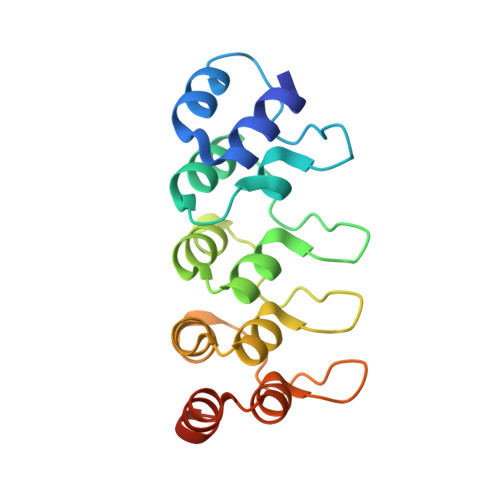Structure-based design of p18INK4c proteins with increased thermodynamic stability and cell cycle inhibitory activity
Venkataramani, R.N., MacLachlan, T.K., Chai, X., El-Deiry, W.S., Marmorstein, R.(2002) J Biological Chem 277: 48827-48833
- PubMed: 12370184
- DOI: https://doi.org/10.1074/jbc.M208061200
- Primary Citation of Related Structures:
1MX2, 1MX4, 1MX6 - PubMed Abstract:
p18(INK4c) is a member of the INK4 family of proteins that regulate the G(1) to S cell cycle transition by binding to and inhibiting the pRb kinase activity of cyclin-dependent kinases 4 and 6. The p16(INK4a) member of the INK4 protein family is altered in a variety of cancers and structure-function studies of the INK4 proteins reveal that the vast majority of missense tumor-derived p16(INK4a) mutations reduce protein thermodynamic stability. Based on this observation, we used p18(INK4c) as a model to test the proposal that INK4 proteins with increased stability might have enhanced cell cycle inhibitory activity. Structure-based mutagenesis was used to prepare p18(INK4c) mutant proteins with a predicted increase in stability. Using this approach, we report the generation of three mutant p18(INK4C) proteins, F71N, F82Q, and F92N, with increased stability toward thermal denaturation of which the F71N mutant also showed an increased stability to chemical denaturation. The x-ray crystal structures of the F71N, F82Q, and F92N p18INK4C mutant proteins were determined to reveal the structural basis for their increased stability properties. Significantly, the F71N mutant also showed enhanced CDK6 interaction and cell cycle inhibitory activity in vivo, as measured using co-immunoprecipitation and transient transfection assays, respectively. These studies show that a structure-based approach to increase the thermodynamic stability of INK4 proteins can be exploited to prepare more biologically active molecules with potential applications for the development of molecules to treat p16(INK4a)-mediated cancers.
- The Wistar Institute, Philadelphia, Pennsylvania 19104, USA.
Organizational Affiliation:
















